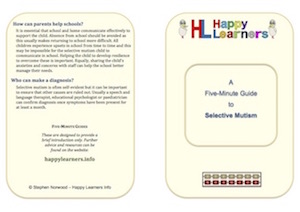Introduction
Selective mutism is a behaviour associated with social anxiety. The individual has the ability to speak but is unable to due to extreme anxiety. The condition can be described as a type of phobia with sufferers experiencing the same feelings of panic and anxiety as other people with severe phobias. The phobia is generally about speaking in front of strangers, people in authority, peers and extended family. Selective mutes will usually speak at home with close family members but will not when unfamiliar people are there or when they are away from home. Attempts to force selective mutes to speak only increase the anxiety associated with speaking and reinforce the phobia.
Selective mutism is generally a temporary developmental condition and over time most will develop functional communication skills. Support with managing the social anxiety aspects of the condition will determine how confident they emerge in their communication as adults.
Diagnosis
Selective mutism is most often diagnosed by a speech and language therapist who will have accessed the child's language ability and their speech production. Sometimes it may be diagnosed by other professionals such as an educational pyschologist. Information will be gathered from the parents about the child's talking in a variety of settings. Children with selective mutism are usually less anxious at home with their immediate family and will often speak in that setting. It may therefore only be after their child starts pre-school that parents become aware of a difficulty.
Selective mutism is categorised as an anxiety disorder and can be diagnosed when symptoms have been present for at least one month and the child has been attending their school or pre-school setting for over a month.
Selective mutism occurs in about 1% of the population. It is more prevalent in girls than boys.
Causes
No specific cause has been identified. Like many developmental conditions there are a multitude of factors that carry an increased risk for selective mutism. These include:
other family members with selective mutism or social anxiety
language difficulties
English as an additional language or time spent abroad exposed to other languages when young
speech production difficulties such as a stammer
autistic spectrum disorder
attachment difficulties
Over excited amygdala
Research in neurobiology suggests that individuals with anxiety disorders have differences in part of their brains called the amygdala. The amygdala, assesses potential danger and this is essential for survival but in those with anxiety disorders it has a lower than average threshold for excitability. This means they are more easily made anxious or fearful in response to perceived danger. For the social mute this danger is anxiety over speaking. Anxious thoughts thus become over powering fears in situations such as parties, social gatherings, unfamiliar people, unfamiliar situations and school.
Difficulties Associated With Selective Mutism
Selective mutism is a spectrum condition with some mutes not speaking in almost all contexts and others speaking in all but a few situations. Clearly, the nature of support required will depend on the extent of the child's needs.
Common characteristics:
Mutism
Timidness and shyness (temperamental inhibition)
Social anxiety - uncomfortable with new people; afraid of being teased or criticised; does not want attention; afraid of making mistakes (perfectionist). Wetting and eating difficulties.
Separation anxiety
Inflexibility, assertiveness and stubbornness in home context. May experience mood swings.
Often complains of physical symptoms such as tummy ache, nausea, shortness of breath, diarrhea.
Lack of expression, awkward body language, poor eye contact
Sensory processing difficulties - 'can cause shutdown'
Other symptoms of anxiety such as skin picking and hair pulling.



